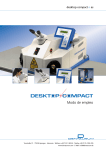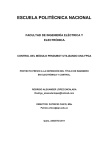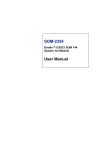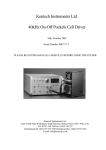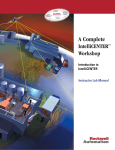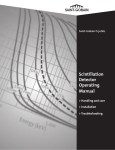Download J0502011 9-Channel Pulser System User Manual
Transcript
Notes on the use of Kentech Instruments Ltd. 9-Channel Pulser System Serial number J0502011 26th July 2005 Kentech Instruments Ltd.,Unit 9,Hall Farm Workshops, South Moreton,Oxon OX11 9AG, UK UK Tel: 01235 510748 UK Fax: 01235 510722 VAT Registration number: GB394526620 Int. Tel: +44 1235 510748 Registered in England No. 1742794 Int. Fax: +44 1235 510722 Registered office: 6a 1st Floor, Popin Business Ctr., South Way, Wembley, London HA9 0HF, UK Email: [email protected] Directors: P.A. Kellett B.A.(Oxon), A.K.L. Dymoke-Bradshaw PhD, J.D. Hares PhD. Web: http://www.kentech.co.uk/ 9-Channel Pulser System i) Caution 9-Channel Pulser System, serial number J0502011 This equipment is a research tool that has been intentionally designed to generate high energy electromagnetic pulses and the EM emissions will be highly sensitive to the load applied by the user. Within the EU it is suitable for use only in a sealed electromagnetic environment, unless it is used in a system that has been verified by the system builder to comply with EU directive 89/336/EEC. With an appropriate load and adequately insulated connecting leads, the unit is safe for use by an educated user in a laboratory environment. You are warned however that the radiation from the system with an antenna or inappropriate load attached can damage sensitive equipment and corrupt data stored in computer and microprocessor based systems. It can cause terminal failure of vital medical electronic systems such as pacemakers. This equipment is be supplied on the understanding that the user will analyse these risks, accept responsibility for them and take appropriate precautions in the use of this instrument. The output from this pulse generator will destroy many types of power attenuators and electronic test equipment. It is the users responsibility to ensure that any apparatus connected to the output is suitably rated. Kentech Instruments Ltd accepts no responsibility for any damage or liabilities incurred in the operation of this equipment. Please read the manual before applying power. THERE ARE DANGEROUS HIGH VOLTAGES (1kV) PRESENT IN THIS PULSER WHEN THE UNIT IS OPERATING. DISCONNECT THE POWER SUPPLY BEFORE REMOVING THE COVERS. Kentech Instruments Ltd Page 2 of 28 July 2005 9-Channel Pulser System ii) Disclaimer This equipment contains high voltage power supplies. Careless can result in electric shocks. It is assumed that this highly specialised equipment will only be used by qualified personnel. Kentech Instruments Ltd accepts no responsibility for any electric shock or injury arising from use or misuse of this product. It is the responsibility of the user to exercise care and common sense with this highly versatile equipment. The main output can be very dangerous, particularly when the pulser is triggered at a high frequency. Take great care to insulate the output adequately. Kentech Instruments Ltd Page 3 of 28 July 2005 9-Channel Pulser System 1. Introduction Our range of solid state high voltage pulse sources allows very high voltage, fast rising pulses to be obtained from compact bench top units. Our avalanche technology allows the generation of 10kV voltage pulses rising in 100ps into 50Ω. Our range of FET pulse generators provides subnanosecond switching speeds, kilovolt amplitudes and repetition rates in excess of 1MHz. The performance of our compact, convenient and reliable pulsers is to our knowledge exceeded only by laser driven photoconductive switches in terms of voltage switching speeds and versatility. These pulsers will find applications in many fields such as high speed camera research, electro-optic switching, triggering systems, time of flight mass spectroscopy and radar. Kentech Instruments Ltd Page 4 of 28 July 2005 9-Channel Pulser System 2. Description of the 9-Channel Pulser System The Kentech Instruments 9-Channel Pulser System (J0502011) is designed to generate -3kV pulses on nine separate outputs, each with a programmable delay of up to 50ns and a programmable bias voltage in the range +/-500V. The Pulser System is controlled and monitored via a serial interface. The Pulser System consists of: • nine high voltage pulse generators (CPS3/M1) which produce the HV output pulses; • one CPS3 Master Control Unit (MCU) which generates the bias voltages and the delayed HV trigger pulses required by the pulse generators; • nine Pulse Forming Modules (PFM) which shape the pulse as required by the user; • RF and power cables; • LabView control interface software to control the Pulser System. CPS3 Master Control Unit Made in England by Kentech Instruments Ltd www.kentech.co.uk Interlock Triggered HV trigger outputs 1 2 CPS3/M1 High voltage pulse generator Made in England by 3 MCP bias (+/-500V) Kentech Instruments Ltd. 5 6 7 MCP bias (+/-500V) Kentech Instruments Ltd. Triggered Trig. amp. output Power Timing monitor Low level trig. input High level trig./bias input Ext./monitor DC bias 500V MCP bias (+/-500V) Kentech Instruments Ltd. Trig. amp. output Low level trig. input High level trig./bias input Ext./monitor DC bias 500V Trig. amp. output Low level trig. input High level trig./bias input Made in England by MCP bias (+/-500V) Kentech Instruments Ltd. MCP bias (+/-500V) Trig. amp. output Trig. amp. output High level trig./bias input Low level trig. input High level trig./bias input Ext./monitor DC bias 500V Triggered Power Timing monitor MCP bias (+/-500V) Trig. amp. output Timing monitor High level trig./bias input Ext./monitor DC bias 500V MCP bias (+/-500V) Kentech Instruments Ltd. HV pulse output (>6kV, 50Ω) CPS3/M1 High voltage pulse generator Made in England by MCP bias (+/-500V) Kentech Instruments Ltd. www.kentech.co.uk Triggered Trig. amp. output Power Timing monitor Triggered Trig. amp. output Timing monitor High level trig./bias input Ext./monitor DC bias 500V ! HV pulse output (>6kV, 50Ω) HV pulse output (>6kV, 50Ω) ! Low level trig. input HV pulse output (>6kV, 50Ω) CPS3/M1 High voltage pulse generator Made in England by Ext./monitor DC bias 500V Ext./monitor DC bias 500V Kentech Instruments Ltd. Power Timing monitor ! Low level trig. input High level trig./bias input CPS3/M1 High voltage pulse generator Made in England by www.kentech.co.uk Triggered Low level trig. input ! www.kentech.co.uk Power Timing monitor www.kentech.co.uk Triggered HV pulse output (>6kV, 50Ω) CPS3/M1 High voltage pulse generator Trig. amp. output ! Kentech Instruments Ltd. Power Timing monitor Ext./monitor DC bias 500V Triggered HV pulse output (>6kV, 50Ω) CPS3/M1 High voltage pulse generator ! Made in England by Power Timing monitor www.kentech.co.uk Triggered MCP bias (+/-500V) Kentech Instruments Ltd. ! www.kentech.co.uk Power CPS3/M1 High voltage pulse generator www.kentech.co.uk Triggered HV pulse output (>6kV, 50Ω) CPS3/M1 High voltage pulse generator Power Trigger input (5V, 50ohms) 9 Made in England by www.kentech.co.uk ! Made in England by 8 CPS3/M1 High voltage pulse generator Made in England by www.kentech.co.uk Power 4 RS232 Low level trig. input High level trig./bias input Ext./monitor DC bias 500V ! HV pulse output (>6kV, 50Ω) Low level trig. input HV pulse output (>6kV, 50Ω) Figure 1 9-Channel Pulser System Kentech Instruments Ltd Page 5 of 28 July 2005 9-Channel Pulser System 3. 9-Channel Pulser System Specification 3.1. Pulse Generator (CPS3/M1) Specification Output pulse amplitude: Permitted bias voltage: Timing monitor: Maximum rep rate: Connectors & Interface: Size: Power supply: Indication: 3.2. Pulse Forming Module (PFM) Specification (when used with CPS3/M1) Output pulse amplitude: Rise time: Fall time: Flatness of top: Pulse width: 3.3. ≥ 6kV negative pulse into 50Ω -500V to +500V ≥ 5V negative pulse 10Hz Low level trigger input (BNC) Trigger amplifier output (SHV) External bias input OR monitor (SHV) High level trigger and bias input (SHV) Timing monitor (SMA) HV pulse output (TNC) MCP bias output (LEMO-'00' series) Mains Power (IEC rear panel) 235mm wide x 98mm high x 30.6mm deep without PFM 110 – 240V AC, 50-60Hz, ~20W Power led Trigger led ≥ 3kV near square negative pulse < 150ps < 250ps < 5% 380 - 400ps near flat top, approx 500ps fwhm Master Control Unit (MCU) Specification Nine independent bias supplies Bias voltage range: -500 to +500V Bias voltage monitor tolerance: ± 1% with 1GΩ load (± 5% with 10MΩ load) Maximum bias current: 50μA Bias current monitor tolerance: ± 1% Nine independent current trips Bias trip current tolerance: ± 5μA Nine independent delay generators Maximum delay: 50ns Delay resolution: 25ps RS232 settings: Connectors & Interface: Maximum rep rate: Kentech Instruments Ltd 9600 baud Low level trigger input (BNC) RS232 port (9 way socket) Interlock connector (LEMO coaxial) 9 x HV trigger and bias outputs (SHV) Mains Power (IEC rear panel) 10Hz Page 6 of 28 July 2005 9-Channel Pulser System Power supply: Size: Indication: 3.4. System Specification Jitter between outputs: Power consumption: 3.5. 110 – 240V AC, 50-60Hz, <20W 19" wide x 3U tall x 400mm deep Power led Trig led <20ps rms <250W Control Interface 1 x Labview driver (virtual instrument) for Master Control Unit Commands include:write desired value for channel n bias voltage read back desired value for channel n bias voltage read measured value from ADC for channel n bias voltage read measured value from ADC for channel n bias current set bias current trip level read back trip status enable all bias voltages individually disable all bias voltages individually read back bias enable status write desired value for delay n read desired value for delay enable all trigger outputs individually disable all trigger outputs individually read back trigger enable status read interlock input status 3.6. Cables 9 x N type to SMA 50Ω coaxial output cables 2m length 9 x SHV to SHV 50Ω coaxial trigger leads 2m length 9 x SHV to SHV 50Ω coaxial trigger short leads (30cm for stand-alone operation) 1 x Lemo connector with 2m flying lead (for interlock input) 10 x US AC IEC power leads. Kentech Instruments Ltd Page 7 of 28 July 2005 9-Channel Pulser System 4. Instrument Description 4.1. Master Control Unit The Master Control Unit (MCU) consists of a microcontroller module, a high voltage trigger generator module and nine Bias/Delay channels. The MCU may be controlled by a PC connected to the front-panel RS232 port. The MCU has a front panel Interlock socket; the interlock signal must be shorted to ground in order to enable the bias voltages on the HV trigger output connectors. CPS3 Master Control Unit Made in England by Kentech Instruments Ltd www.kentech.co.uk Interlock HV trigger outputs 1 2 3 4 5 6 7 8 9 Triggered RS232 Trigger input (5V, 50ohms) Power Figure 2 MCU Front Panel The MCU is triggered by a 5V positive edge on the Trigger input (BNC) connector. A high voltage pulse is generated and split into each of the nine channels. These 500V pulses propergate in parallel through the nine programmable delay channels and are finally combined with the programmable bias voltages at the HV trigger output (SHV) connectors. An EEPROM Write Enable button has been fitted to the rear of the MCU. This button should be used only when reprograming the calibration data. Contact Kentech Instruments for more information. The MCU contains nine separate bias generators which can be individually programmed to give different bias settings on each channel. A single current limit can be set for all the channels. If the bias current on any channel exceeds this limit, the bias will be disabled. Each channel has its own programmable delay generator. The user may delay each output pulse by up to 50ns, with a resolution of approximately 25ps. 4.2. CPS3/M1 pulse generators The CPS3/M1 pulse generators produce ≥6kV negative unshaped pulse with a rise-time of approximately 100ps. The Pulse Forming Modules (PFMs) shape the output waveform to produce a ≥3kV negative pulse with a length of approximately 500ps. Kentech Instruments Ltd Page 8 of 28 July 2005 9-Channel Pulser System CPS3/M1 High voltage pulse generator Made in England by MCP bias (+/-500V) Kentech Instruments Ltd. PFM www.kentech.co.uk Power Triggered Trig. amp. output Timing monitor ! Low level trig. input High level trig./bias input Ext./monitor DC bias 500V PFM output (N) HV pulse output (>6kV, 50Ω) Figure 3 CPS3/M1 Front Panel Note: these pulse generators must NOT be operated without a Pulse Forming Module. Operating without proper termination may damage the equipment. As part of the Nine-Channel Pulser System, each CPS3/M1 pulse generator is triggered by one of the HV trigger output signals from the MCU. This signal is fed into the pulse generator's High level trig./bias input (SHV) connector (see Figure 4). Within the pulse generator, the high voltage trigger signal is stripped away from the bias and used to excite the avalanche transistor stacks to produce a -3kV output pulse. This output pulse is then recombined with the bias within the Pulse Forming Module. CPS3/M1 & PFM Main stacks Trigger stack PFM Low level trig. input (BNC) Trig. amp. output (SHV) High level trig./bias input (SHV) HV trigger outputs (SHV) MCU Timing monitor (SMA) Input Oscilloscope PFM output (N) Trigger input (SMA) User equipment Ext./monitor DC bias 500V (SHV) HV input >=1GΩ Voltmeter Figure 4 CPS3/M1 Pulser System Operation The user may monitor the timing and amplitude of the output pulse by observing the Timing monitor (SMA) output. The output signal at this point is approximately 5V into 50Ω for a 3kV output pulse. The bias voltage may also be monitored at the Ext./monitor DC bias 500V (SHV) connector. The impedance of the monitoring circuit should be ≥1GΩ. 4.3. Use of the CPS3/M1 in Stand-Alone Operation The CPS3/M1 may be triggered directly from a low voltage signal when not used as part of this pulser system. In stand-alone operation, a HV trigger signal is produced within the pulse generator Kentech Instruments Ltd Page 9 of 28 July 2005 9-Channel Pulser System and is available at the Trig. amp. output (SHV) connector. This trigger signal must be connected directly to the High level trig./bias input (SHV) connector (see Figure 5). If a bias voltage is required at the output, it must be generated by external equipment and introduced at the Ext./monitor DC bias 500V (SHV) connector. The bias will be combined with the HV output pulse within the PFM. CPS3/M1 & PFM Main stacks Trigger stack PFM Low level trig. input (BNC) Trig. amp. output (SHV) High level trig./bias input (SHV) Timing monitor (SMA) Pulse output 5V, 50Ω Input Pulse Generator Oscilloscope PFM output (N) Trigger input (SMA) User equipment Ext./monitor DC bias 500V (SHV) HV output Bias Generator Figure 5 CPS3/M1 Stand-Alone Operation 4.4. The Pulse Forming Modules (PFMs) The PFM sets the length of the pulse and couples it onto the output N-type connector, which is held at the bias voltage. Although the pulse generators produce very similar pulses, and the PFMs have similar characteristics, it is intended that the pulse generators are matched with specific PFMs. For example, it is recommended that Channel 1 of the MCU is connected to the pulse generator number J0502011/CPS3/1 using the SHV cable marked '1' and that the PFM J0502011/PFM1 is used with this channel. The HV pulses produced by both the MCU and the CPS3/M1 will cause damage to test equipment if precautions are not taken. If it is necessary to monitor or characterise the output pulse, suitable attenuators should be used. We recommend the use of a high voltage, high speed attenuator manufactured by Barth™ as the first attenuator in a series. Kentech Instruments Ltd Page 10 of 28 July 2005 9-Channel Pulser System 5. LabView Control Interface Program The 9-Channel Pulser System may be controlled and monitored by means of a LabView virtual instrument. Commands may also be transferred directly using any standard terminal program. Commands and data are transferred through the RS232 interface. 5.1. Starting the Control Interface Program 1. Copy the file called “cps9.cfg” to the Labview main directory (for example c:\Program Files\National Instruments\LabVIEW 7.1). 2. Start Labview. 3. Click the Open buttton and open the library file “cps3x9_Control_Interface.llb”. From the File Dialog choose CPS3x9_Control_Interface_main.vi . 4. Before running the instrument you will need to select the apropriate COM port in the “VISA resource name” combox. (Click Cntl-M and select port). 5. Click the “Run” button in the main Labiew menu. 6. The VI starts. If there is a problem in communcation between the program and the instrument the “Comm Error” LED will change to red. If “Comm Error” is dim the communication between the program and the instrument is ok. 5.2. Using the Control Interface The Control Interface is a set of LEDs, buttons, switches and edit boxes to help you to send commands and get the status of the system. Figure 6 LabView Control Interface Kentech Instruments Ltd Page 11 of 28 July 2005 9-Channel Pulser System “Trigger latched” will be ON (yellow) after the first triggered event and stay on until you press the “Trigger reset” button. “Interlock ok” will be ON (green) while the interlock is connected and off when you pull out the interlock plug. In this case “Interlock latched” will come ON (red). All Trigger enable signals will be switched off. “Update Itrip” and “Update” buttons will flash to remind you to update the system. “Tripped” will be ON (red) if the current taken from any of the 9 channels has exceeded the preset Itrip level. All Biases and Trigger enable signals will be switched off. To reset the tripped state press the “Trip reset” button. The “Itrip Update” and “Update” buttons will flash to remind you to update the system. You can set the trip current level with “Update button”. Each channel is represented within a single line of controls and indicators (marked 1-9). “Set Vbias” - is a control to set the bias voltage. “Vbias Monitor” - is an indicator to show the bias on the output of the channel. “IbiasMonitor” - is an indicator to show the current taken from the output of the channel. “BiasEnable” - is a control to switch on the bias voltage on the output of the channel. “BiasOn?” - is an indicator to show if the bias voltage is enabled on the output of the channel. “Tripped” - is an indicator to show the bias current tripped state for that channel. “Trigger enable”- is a control to enable triggering of the channel. “Trigger on?” - is an indicator to show the trigger enable state for the channel. “Delay” - is a control to set the delay of the output signal to the pulser in relation to the trigger signal. “Update” button will send the commands to the intrument (all 9 chanels are being updated). Whenever you change one of the settings in any of the controls, the “Update” button will flash. “Safe” button will switch off all the Biases and Trigger enable signals. “Save default status” will save the present settings of all the channels and Itrip setting in the default config file “cps9.cfg”. When the program starts it restores all the setting from “cps9.cfg” file. You can save the present settings in a different config file by pressing “Save status to file”, and restore the settings from the saved file by pressing “Restore status from the file”. “Stop program” - to stop running the program. To communicate with the instrument you will have to set the right COM port in the “Visa resource name” combox. The port setting will be remembered when you stop the program. Next time you run the program it will restore the port settings from the default config file. Each button can be operated by a “Hot Key” as indicated on each button, see figure above. Kentech Instruments Ltd Page 12 of 28 July 2005 9-Channel Pulser System 6. Output Waveforms Output pulse (brown trace) 500V/div Timing monitor (green trace) 5V/div All traces 1ns/div Figure 7 J0502011/CPS3/1 Figure 8 J0502011/CPS3/2 Kentech Instruments Ltd Page 13 of 28 July 2005 9-Channel Pulser System Figure 9 J0502011/CPS3/3 Figure 10 J0502011/CPS3/4 Kentech Instruments Ltd Page 14 of 28 July 2005 9-Channel Pulser System Figure 11 J0502011/CPS3/5 Figure 12 J0502011/CPS3/6 Kentech Instruments Ltd Page 15 of 28 July 2005 9-Channel Pulser System Figure 13 J0502011/CPS3/7 Figure 14 J0502011/CPS3/8 Kentech Instruments Ltd Page 16 of 28 July 2005 9-Channel Pulser System Figure 15 J0502011/CPS3/9 Kentech Instruments Ltd Page 17 of 28 July 2005 9-Channel Pulser System 7. Test Results Test results recorded on 22 July 2005. 7.1. Absolute Channel Delays The absolute delay, measured from system trigger input to pulse output on channel 1, is approximately 44.6ns. The following table shows the delays of the other channels relative to channel 1. Channel 1 2 3 4 5 6 7 8 9 7.2. delay / ps 0 59 34 51 20 47 -45 76 71 Relative Channel Delays The following table shows the delay observed in each channel when programmed with a range of nominal values from 0 to 50ns. The delays are measured relative to zero delay for that channel. Channel 1 2 3 4 5 6 7 8 9 Kentech Instruments Ltd 0 0.00 0.00 0.00 0.00 0.00 0.00 0.00 0.00 0.00 10 10.01 9.99 10.01 10.00 10.01 10.01 10.03 10.00 10.03 Delay 20 20.03 20.00 20.01 20.02 20.04 20.02 20.04 20.01 20.04 / ns 30 30.02 30.02 30.03 30.03 30.06 30.04 30.07 30.02 30.07 Page 18 of 28 40 40.06 40.05 40.08 40.09 40.07 40.08 40.09 40.09 40.11 50 50.09 50.09 50.14 50.12 50.13 50.11 50.15 50.12 50.15 July 2005 9-Channel Pulser System 7.3. Bias Supplies Bias Supply voltages into 1GΩ. Channel 1 2 3 4 5 6 7 8 9 Source Actual Monitor Actual Monitor Actual Monitor Actual Monitor Actual Monitor Actual Monitor Actual Monitor Actual Monitor Actual Monitor -500 -500 -499 -500 -500 -499 -499 -502 -499 -500 -500 -500 -500 -502 -500 -499 -500 -501 -500 -400 -401 -399 -401 -400 -400 -399 -402 -399 -401 -399 -401 -400 -402 -399 -400 -400 -402 -399 -300 -302 -299 -303 -300 -302 -299 -303 -299 -302 -299 -302 -300 -303 -299 -302 -299 -302 -299 -200 -203 -199 -203 -199 -202 -199 -201 -198 -202 -198 -202 -198 -202 -198 -201 -198 -202 -198 Programmed Voltage /V -100 0 100 -103 25 103 -98 24 98 -103 23 103 -99 22 99 -103 24 103 -98 23 98 -102 22 102 -98 22 97 -102 24 103 -98 23 98 -102 27 102 -98 26 97 -103 24 103 -98 23 98 -102 25 103 -99 24 98 -102 19 102 -98 19 97 200 204 199 204 199 204 198 202 198 204 198 204 198 204 199 204 199 202 197 300 299 301 299 301 299 300 300 299 299 300 301 300 301 299 301 300 298 300 400 400 399 401 399 401 399 398 399 400 399 399 399 400 399 400 399 399 399 500 499 499 500 499 501 500 498 499 500 500 499 499 500 500 500 500 498 499 Bias Supply voltages into 10MΩ. -500 Programmed Voltage /V -100 100 500 I Actual Monitor I Monitor Actual Monitor I Monitor Actual Monitor Monitor Actual Monitor I Monitor Channel V V uA V V uA V V uA V V uA 1 -491 -499 -49 -99.9 -98 -9 99.8 97 10 487 499 49 2 -492 -500 -49 -100 -98 -10 100 98 10 487 499 48 3 -490 -500 -49 -100 -98 -10 100 100 9 488 500 49 4 -493 -499 -50 -99 -97 -10 98 97 9 485 499 49 5 -492 -499 -49 -100 -97 -9 99 97 10 487 500 49 6 -492 -500 -50 -99 -97 -10 99 97 9 486 500 49 7 -493 -500 -50 -100 -98 -10 100 97 9 487 500 49 8 -491 -500 -49 -99 -97 -10 99 98 9 487 500 49 9 -492 -499 -49 -99 -97 -10 99 97 9 485 500 49 Kentech Instruments Ltd Page 19 of 28 July 2005 9-Channel Pulser System 8. CPS3x9 Control Unit RS232 interface 1/07/05 8.1. General Notes 1. If trip or interlock latches are set, the control unit will ignore attempts to enable the bias supplies. Therefore the trip or interlock latches should be reset before attempting to enable supplies. 2. The MCU behaviour on interlock fail is determined by a flag in eeprom called safeoninter? Interlock fail always causes the bias supplies to be disabled. If safeoninter? is high, the trigger outputs will also be disabled - equivalent to executing a safe command. If safeoninter? is low, the trigger outputs are not affected. It is possible to modify the state of this flag but not using the normal protocol. 3. The software refers to channel numbers as 0 thru 8 as opposed to the natural user description 1 thru 9. 8.2. The protocol The MCU uses a restricted protocol for reliable control. It is not be possible to download code to the MCU or edit flags and calibration data using this protocol. It is possible to change protocol mode and use the full Forth interpreter which allows all flags and calibration data to be edited, or a new version of source code to be downloaded but this is not covered in this document. The MCU generates responses to valid commands and does not generate any unsolicited output. Invalid commands are ignored. All commands and response are in ASCII characters. Commands are case sensitive. In the interest of simplicity all commands are parsed by the MCU using the Forth interpreter, so the parameters need to be delimited by spaces and the command line has to be terminated by carriage return and linefeed characters. The Forth interpreter will not recognise any commands other than those defined in the command set. The MCU will not echo command characters as they are received, no output is generated until a valid command is recognised. When a valid command is recognised, the MCU outputs a response. Responses are preceeded with a cr and lf, then an ascii { character and end with an ascii }. The response is delimited into fields by an ascii ; character. The first field in the response will be a repeat of the command. If the command cannot be completed the MCU will return an error code in the second field. The possible error codes are:- the command interpreter has detected a wrong stack depth error, ie the wrong number of parameters have been received. ?param - the command interpreter has detected an out of range parameter ?stack After any error, the command is not executed, the stack is cleared and no values are returned other than the error code. Following a stack error, the stack is cleared then dummy parameters (generally -1 or 65536) are added for the purpose of formatting the response only. Kentech Instruments Ltd Page 20 of 28 July 2005 9-Channel Pulser System All status commands expect and deliver data as decimal numbers and all numeric data should be decimal, no decimal points or other punctuation to be used. For example 1) to set the desired value of coarse delay to 5ns on channel 3, the command would be:5000 3 !d and the response if the command can be completed would be:{5000 3 !d} 2) as above but with a missing parameter 3 !d and the response would be:{-1 -1 !d;?stack} The command interpreter detects the wrong stack depth, corrects this by clearing the stack and adding some dummy parameters then flags the error. No execution will result. 3) as above with invalid parameter 5000 9 !d and the response would be:{5000 9 !d;?param} Again no execution will result. 4) to read the measure value of bias voltage 2 2 @>vb and the response if the command can be completed would be:{2 @>vb; 100} which implies the voltage is 100V. 5) as above but with a missing parameter @>vb Kentech Instruments Ltd Page 21 of 28 July 2005 9-Channel Pulser System and the response would be {-1 @>vb; ?stack} 6) as above but with an invalid parameter 9 @>vb and the response would be {9 @>vb; ?param} Bias Trip status bits Default to zero on reset/power up. These bits are reset by tripreset command. This register is intended to allow identification of source channel of trip. b0 b1 b2 b3 b4 b5 b6 b7 b8 b9 b10 b11 b12 b13 b14 = bias 0 tripped? = bias 1 tripped? = bias 2 tripped? = bias 3 tripped? = bias 4 tripped? = bias 5 tripped? = bias 6 tripped? = bias 7 tripped? = bias 8 tripped? = not used = not used = not used = not used = not used = not used ro ( 1= tripped on this channel) ro ( 1= tripped on this channel) ro ( 1= tripped on this channel) ro ( 1= tripped on this channel) ro ( 1= tripped on this channel) ro ( 1= tripped on this channel) ro ( 1= tripped on this channel) ro ( 1= tripped on this channel) ro ( 1= tripped on this channel) Bias User Enable status bits Default to zero on reset/power up. These are all reset by interlock fail or a trip condition. After reseting interlock or trip you need to reload these. These bits can only be set if the trip and interlock latches are zero. b0 b1 b2 b3 b4 b5 = bias 0 = bias 1 = bias 2 = bias 3 = bias 4 = bias 5 enable? enable? enable? enable? enable? enable? Kentech Instruments Ltd rw ( 1 = enable) rw ( 1 = enable) rw ( 1 = enable) rw ( 1 = enable) rw ( 1 = enable) rw ( 1 = enable) Page 22 of 28 July 2005 9-Channel Pulser System b6 b7 b8 b9 b10 b11 b12 b13 b14 = bias 6 enable? = bias 7 enable? = bias 8 enable? = not used = not used = not used = not used = not used = not used rw ( 1 = enable) rw ( 1 = enable) rw ( 1 = enable) Bias Hardware Enable status bits These reflect the state of the enable outputs to the bias power supplies. b12 - Trigger latch - is set by a trigger condition, reset by the TriggerReset command b13 - Interlock fail latch - is set buy the interlock circuit failing, reset by InterlockReset command. b0 b1 b2 b3 b4 b5 b6 b7 b8 b9 b10 b11 b12 b13 b14 = bias 0 on? r0 ( 1/0 = on/off) = bias 1 on? r0 ( 1/0 = on/off) = bias 2 on? r0 ( 1/0 = on/off) = bias 3 on? r0 ( 1/0 = on/off) = bias 4 on? r0 ( 1/0 = on/off) = bias 5 on? r0 ( 1/0 = on/off) = bias 6 on? r0 ( 1/0 = on/off) = bias 7 on? r0 ( 1/0 = on/off) = bias 8 on? r0 ( 1/0 = on/off) = not used = not used = not used = Trigger latch ( 1 = triggered) = Interlock fail latch ( 1 = interlock has failed, 0 = ok) = hw enable? ro ( 1 = interlock is ok, 0 = not ok) Trigger user enable status bits Default to zero on reset/power up. These bits are reset by a trip event If the SafeOnInter? flag is hi, these bits are also reset by an interlock failure. After reseting interlock or trip you need to reload these. These bits can only be set if the trip latch is zero. If the SafeOnInter? flag is hi, these bits can only be set if the interlock latch is also zero. b0 b1 b2 b3 = trigger 0 enable? = trigger 1 enable? = trigger 2 enable? = trigger 3 enable? Kentech Instruments Ltd rw rw rw rw Page 23 of 28 July 2005 9-Channel Pulser System b4 b5 b6 b7 b8 b9 b10 b11 b12 b13 b14 b15 = trigger 4 enable? = trigger 5 enable? = trigger 6 enable? = trigger 7 enable? = trigger 8 enable? = not used = not used = not used = not used = not used = not used = not used rw rw rw rw rw Trigger hardware enable status bits:These reflect the state of the enable outputs to the trigger unit. b0 b1 b2 b3 b4 b5 b6 b7 b8 b9 b10 b11 b12 b13 b14 b15 8.3. = trigger 0 on? ro = trigger 1 on? ro = trigger 2 on? ro = trigger 3 on? ro = trigger 4 on? ro = trigger 5 on? ro = trigger 6 on? ro = trigger 7 on? ro = trigger 8 on? ro = not used = not used = not used = not used = not used = not used = hw enable? ro (read to find state of hw interlock ) The Control Commands a) bias outputs Name Explanation Format parameter 1 parameter 2 returned value !vbias write desired value for bias voltage x n !vb x = voltage, range -500 to 500 volts n = channel number 0 thru 8 none Kentech Instruments Ltd Page 24 of 28 July 2005 9-Channel Pulser System Name Explanation Format parameter 1 parameter 2 returned value @vbias read desired value for bias voltage Name Explanation Format parameter 1 parameter 2 returned value @>vbias read absolute measured value for bias voltage Name Explanation Format parameter 1 parameter 2 returned value @>ibias read absolute measured value for bias current Name Explanation Format parameter 1 parameter 2 returned value !itrip write desired absolute value for bias current trip Name Explanation Format parameter 1 parameter 2 returned value @itrip read desired absolute value for phosphor current trip Name Explanation Format parameter 1 parameter 2 returned value @tripstatus read bias trip status Name Explanation Format parameter 1 parameter 2 returned value @biasstatus read bias user enable status n @vb n = channel number 0 thru 8 none desired value in volts n @>vb n = channel number 0 thru 8 none measured value in volts n @>ib n = channel number 0 thru 8 none measured value in uA?? x n !it x = current in uA, range 0 to 20 n = channel number 0 thru 8 none n @it n = channel number 0 thru 8 none current in uA, range 0 to 20 @tp% none none pulser status @b% none none pulser status Kentech Instruments Ltd Page 25 of 28 July 2005 9-Channel Pulser System Name Explanation Format parameter 1 parameter 2 returned value !biasstatus write bias user enable status Name Explanation Format parameter 1 parameter 2 returned value @>biastatus read bias hardware enable status n !b% bias user enable status none none @>b% none none bias hardware enable status b) trigger outputs Name Explanation Format parameter 1 parameter 2 returned value @triggerstatus read trigger user enable status Name Explanation Format parameter 1 parameter 2 returned value !triggerstatus write trigger user enable status Name Explanation Format parameter 1 parameter 2 returned value @>triggerstatus read trigger hardware enable status @tg% none none trigger enable status x !tg% x = trigger enable status none none @>tg% none none trigger enable status c) delays Name Explanation Format parameter 1 parameter 2 returned value !delay write desired value for delay x n !d x = delay, range 0 to 50,000 ps ( rounded down internally to multiples of 25ps) n = channel number 0 thru 8 none Kentech Instruments Ltd Page 26 of 28 July 2005 9-Channel Pulser System Name Explanation Format parameter 1 parameter 2 returned value @delay read desired value for delay Name Explanation safe disable everything, equivalent to:0 !triggerstatus 0 !biasstatus Format parameter 1 parameter 2 returned value safe Name Explanation Format parameter 1 parameter 2 returned value @version# read software version number. Name Explanation Format parameter 1 parameter 2 returned value InterlockReset Reset interlock latch Name Explanation Format parameter 1 parameter 2 returned value TripReset Reset trip latch Name Explanation Format parameter 1 parameter 2 returned value TriggerReset Reset trig latch n @d n = channel number 0 thru 8 none desired value in picoseconds none none none @v# none none version number 0int none none none 0trp none none none 0trg none none none Kentech Instruments Ltd Page 27 of 28 July 2005 9-Channel Pulser System d) New commands added to facilitate Labview driver Name Eplanation Format Parameter 1 Parameter 2 Returned value1 Returned value2 Returned value3 Returned value4 Returned value5 Returned value6 ChannelLook Read all measure parameters for one channel Name Eplanation Format Parameter 1 Parameter 2 Returned value1 Returned value2 Returned value3 Returned value4 SystemLook Read all measure parameters for system Name Eplanation Format Parameter 1 Parameter 2 Parameter 3 Parameter 4 Parameter 5 Returned value1 Channelset Set all parameters for one channel Name Eplanation Format Parameter 1 Parameter 2 Parameter 3 Parameter 4 Parameter 5 Returned value1 Systemset Set all parameters for system n chl channel number 0 thru 8 none. channel no. vbias ibias tripped? biasen? trigen? syl none none. triplatch triglatch interlock latch interlock cct p1 p2 p3 p4 p5 chs vbias delay 1 = EnableBiase 1 = EnableTrigger channel number 0 thru 8 none p1 p2 p3 p4 p5 chs itrip 1 = TripReset 1 = TriggerReset 1 = InterlockReset none none Kentech Instruments Ltd Page 28 of 28 July 2005




























